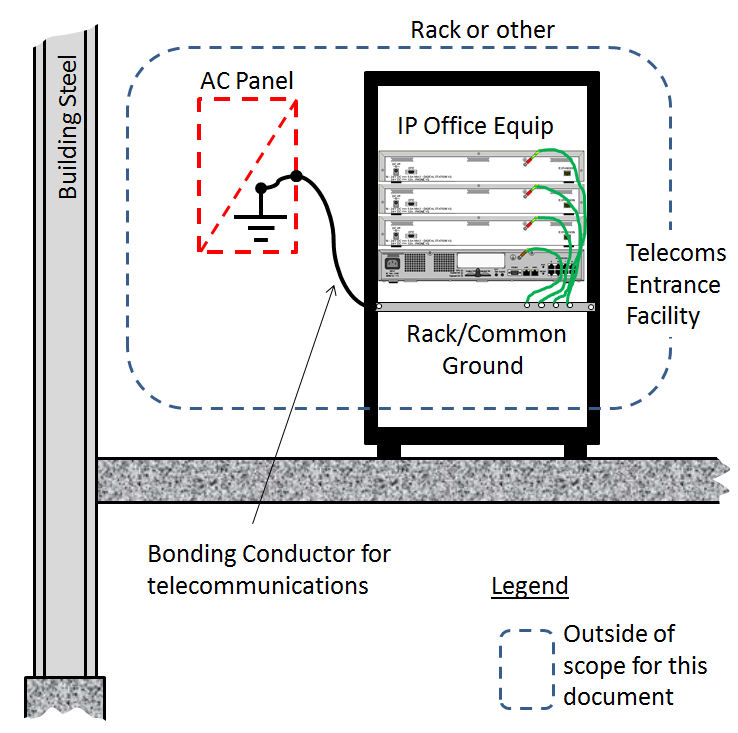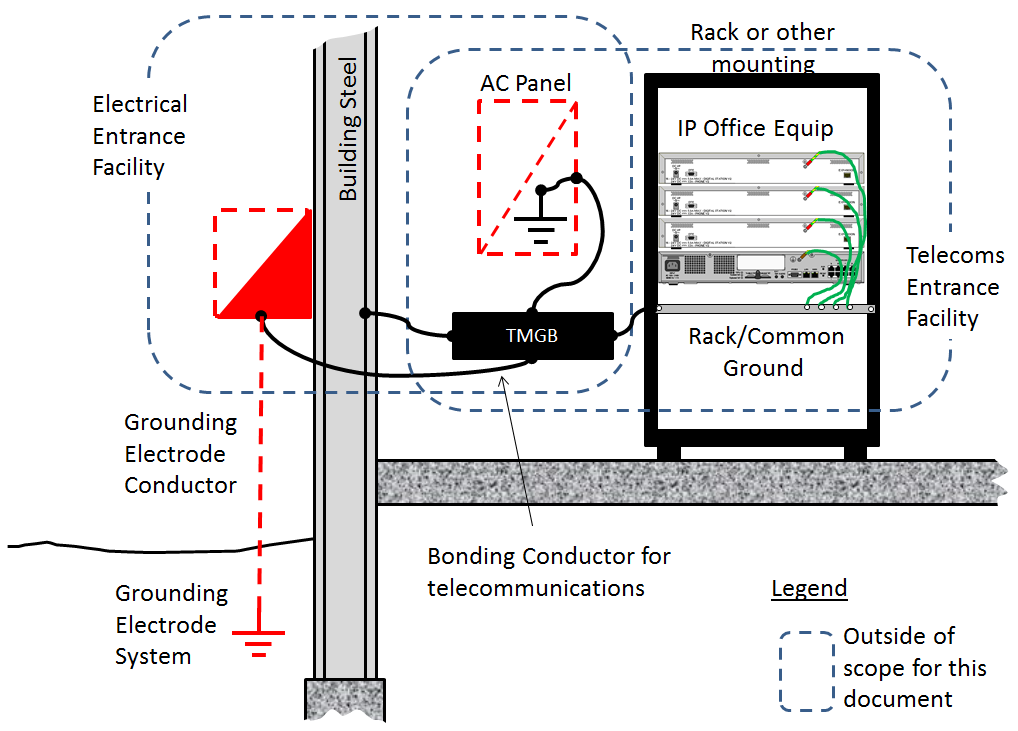Tip Number: 273
<Prev Next>, 17th December 2014,  Original PDF Version
Original PDF Version
Tip Number: 273
<Prev Next>, 17th December 2014,  Original PDF Version
Original PDF Version
This Technical Tip gives Business Partners detailed guidance on the requirement of electrical earthing for IP Office installations.
Grounding circuit continuity is necessary for safe operation of this telecommunications equipment. Never operate this telecommunications equipment with grounding conductor disconnected. Earth connection is essential before making any telecommunications network connections due to high leakage current and high touch current.
Failure to follow grounding recommendations can result is a system installation that is:
Unsafe for personnel handling or using the equipment
Not properly protected from lightning or power transients
Subject to service interruptions
The earthing (grounding) and bonding of an Avaya Telephony system in customer premises shall follow national and/or local electrical codes/standards if these codes/standards exist. Examples of these codes are NFPA 70/NEC (USA), BS 7671 (UK IEE Wiring Regulations) and VDE 0100 (Germany). Examples of these standards are ANSI/TIA/ EIAJSTD-607-B, ANSI/TIA/EIA-568-C (USA), EN 50174-2 and EN 50310 (Europe) and IEC 60364-5-548 (International).
The first (A) is based on NFPA 70: National Electrical Code (NEC - a United States code).
Note: Compliance with NFPA 70: NEC - or - with the equivalent local electrical code / grounding requirements is mandatory.
The second (B) is based on ANSI/EIA/TIA-607 (Commercial Building Grounding (Earthing) and Bonding Requirements for Telecommunications).
Note: ANSI/EIA/TIA-607 (TIA-607) defines an intra-building ground-wiring scheme for communications equipment, and specifies equipment connection / grounding points according to that scheme. TIA-607 assumes the underlying building grounding infrastructure is in compliance with NFPA 70: NEC. Compliance with the NEC (or the equivalent local electrical code / grounding requirements) is essential for the proper application of TIA-607.
Compliance with NFPA 70: NEC will provide suitable grounding for the Avaya equipment. TIA-607 provides an enhanced, communications-specific grounding scheme: where TIA-607 has been implemented, the Avaya equipment shall be grounded per this method.
Ensure that the installation site has access to approved grounds and that either a trained technician or a licensed electrician will be verifying all grounds and installing the Supplementary Ground Conductor.
If you have difficulty interpreting the grounding methods in this document, Avaya recommends obtaining the services of a certified power contractor or auditor prior to system installation or cutover.
The IP Office Equipment must have a permanently connected, hard wired protective earth connection that remains installed correctly as per IP500V2 Installation documentation.
Specifically system grounding must adhere to the following requirements:
The ground path must have an impedance of 4 ohms or less.
IP500V2 Installation documentation recommends the use of at least #14 AWG wire. The thicker the wire the lower the resistance to ground. See Table 1 Area-specific ground wire requirements below for a list of grounding wire requirements specific to some areas.
Ground conductors must not carry current under normal operating conditions.
Eliminate possible ground loops1 from the installation by having a common ground.
Spliced conductors must not be used. Continuous conductors have lower impedance and are more reliable.
All conductors must terminate in a permanent way. Make sure all terminations are easily visible and available for maintenance purposes.
Tag ground connections with a clear message such as "CRITICAL CONNECTION: DO NOT REMOVE OR DISCONNECT."
1According to the Telecommunications Industry Association (TIA), "Ground loop in an electrical system is an unwanted current that flows in a conductor connecting two points that are nominally at the same potential, i.e., ground, but are actually at different potentials"
Table 1 Area-specific ground wire requirements
Region Rules | Wire Size | Comments |
Germany | #8 AWG (10 mm2) | green/yellow wire |
Other areas in Europe | Not smaller than #6 AWG (16 mm2) at any point | - |
UK | Not smaller than #8 AWG (10mm2) | Two green/yellow wires |
Brazil | Not smaller than #6 AWG (16 mm2) at any point | ESD requirement in country |
In buildings without a ground-cabling infrastructure meeting TIA-607 the Avaya equipment shall be grounded by connection to the nearest accessible location on one of the following approved building grounds:
Note: The following are approved grounds in keeping with the NFPA 70: National Electrical Code of the United States (NEC). For additional information regarding these grounds consult the NEC, Article 250.52.
This is the recommended location for grounding Avaya telephony equipment.
AC ground at the AC service panel serving the Avaya equipment. See Error! eference source not found.
The equipment rack should not be grounded anywhere else and if it's bolted to a concrete floor, it should be insulated from the mounting bolts to prevent unwanted grounding thru the re-bar in the floor.
! Danger ! |
As alternatives:
The water pipe must meet all the following –
The entire length of the pipe must be visible – except for short sections passing through walls, ceilings, etc.
Be metallic thorough its length, or made electrically continuous by bonding around insulation joints or insulating pipe.
Be routed underground for at least 3 meters (10 feet).
Where a metal water pipe is used as an approved ground the following requirements apply to the host building:
The building must be industrial, commercial, or institutional, where only qualified persons service the water piping.
The building shall not rely only on the metal water pipe for grounding: a supplemental ground is required. (See NEC Article 250.53 for additional details.)
The metal frame member (I-beam, pillar) must be connected to earth by one of the following methods –
Be in direct contact with the earth, or encased in concrete that is in direct contact with the earth, for at least 3 meters (10 feet).
Be connected to the reinforcing bars of a concrete-encased electrode. The electrode must be encased by at least 5.1 cm (2 inches) of concrete and located within and near the bottom of a concrete foundation or footing in direct contact with the earth. The electrode must be at least 6.1 meters (20 feet) of one or more steel reinforcing bars or rods, 1.3 cm (0.5 inches) in diameter, or at least 6.1 meters (20 feet) of bare solid copper, 4 AWG (26mm2) wire.
Be connected to a ground ring. A ground ring is a buried ground that encircles a building, having a length of at least 6.1 meters (20 feet) of 2 AWG (35mm2) bare copper wire.
Be connected to rod and pipe electrodes. A rod or pipe electrode consists of one 1.6 cm (5/8 inch) solid rod or 2 cm (3/5 inch) conduit driven to a minimum depth of 2.4 meters (8 feet).
Be connected to plate electrodes. Plate electrodes have a minimum of 0.185 square meter (2 square feet) of metallic surface exposed to the exterior soil.
Floor grounds are those grounds on each floor of a high-rise building that are suitable for connection to the ground terminal in the riser closet and to the equipment single-point ground terminal. Approved floor grounds may include the following:
Metal Frame of the Building (in accordance with the criteria specified in TIA-607)
The grounding conductor for the secondary side of the power transformer feeding the floor
A grounding point specifically provided in the building for that purpose

Figure 1 Method A -1 Connection to AC Panel Ground
In buildings where a ground-cabling infrastructure meeting TIA-607 has been implemented the Avaya equipment shall be grounded according to the TIA-607 standard. In a TIA-607 installation, the Telecommunications Main Grounding Busbar (TMGB) / Telecommunications Grounding Busbar (TGB) links the telecommunications equipment to the ground.
Other grounding terminology is:
Building principle ground, normally in a building with one floor.
Floor ground bar, normally in buildings with more than one floor.
Refer to TIA-607-B September 2011
Configure telecommunications subsystems, such as groups of frames or equipment, as separate single-point ground entities connected to the equipment¡¦s dedicated service panel via a single-point ground bar. The service panel ground connects to the building principle ground via the main service panel or, in a TIA-607 installation, via the TGB (Telecommunications Grounding Busbar).

Refer to Figure 2: Ground-cabling infrastructure meeting TIA-607
!Warning! |